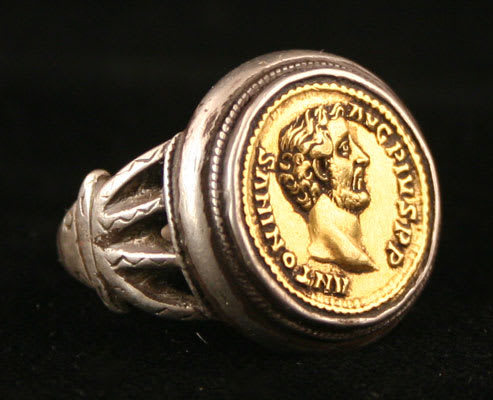Classical Revival Silver Ring Featuring a Gold Coin of Emperor Antoninus Pius, 18th Century CE - 19th Century CE
Gold and Silver
FJ.7174
Both the silver setting and the gold coin date to the Classical Revival period, evoking the Ancient Roman style. Antoninus Pius is regarded as one of the 'Five Good Emperors'...
Both the silver setting and the gold coin date to the Classical Revival period, evoking the Ancient Roman style.
Antoninus Pius is regarded as one of the "Five Good Emperors" in Roman history. He was born in 86 AD. Around 133-136, he served in Asia as proconsul, and there he earned the respect of Emperor Hadrian. After Hadrian's return from the Jewish war, Antoninus was made a member of his council not only on grounds of friendships and family connection, but also because of his experience as a jurist and administrator. After the sudden death of Lucius Aelius Caesar, Antoninus was officially adopted by Hadrian on February 25, 138 as successor to the throne. After administering the imperial offices, Hadrian died and Antoninus became emperor. Antoninus married Faustina and they had four children: two sons and two daughters. However, only one daughter was alive at the time of his adoption by Hadrian. Later, he adopted Marcus Aurelius, who was to be the successor to his throne. In 139, he gave to Marcus the name of Caesar and made him consul designate. In 146, Aurelius was recognized as Antoninus's colleague in rule, and the hopes of Rome and the fortunes of the dynasty rested upon him. Antoninus managed to govern the empire capably and yet with such a gentle hand that he earned the respect, acclaim, and love of his subjects.
Antoninus Pius is regarded as one of the "Five Good Emperors" in Roman history. He was born in 86 AD. Around 133-136, he served in Asia as proconsul, and there he earned the respect of Emperor Hadrian. After Hadrian's return from the Jewish war, Antoninus was made a member of his council not only on grounds of friendships and family connection, but also because of his experience as a jurist and administrator. After the sudden death of Lucius Aelius Caesar, Antoninus was officially adopted by Hadrian on February 25, 138 as successor to the throne. After administering the imperial offices, Hadrian died and Antoninus became emperor. Antoninus married Faustina and they had four children: two sons and two daughters. However, only one daughter was alive at the time of his adoption by Hadrian. Later, he adopted Marcus Aurelius, who was to be the successor to his throne. In 139, he gave to Marcus the name of Caesar and made him consul designate. In 146, Aurelius was recognized as Antoninus's colleague in rule, and the hopes of Rome and the fortunes of the dynasty rested upon him. Antoninus managed to govern the empire capably and yet with such a gentle hand that he earned the respect, acclaim, and love of his subjects.



